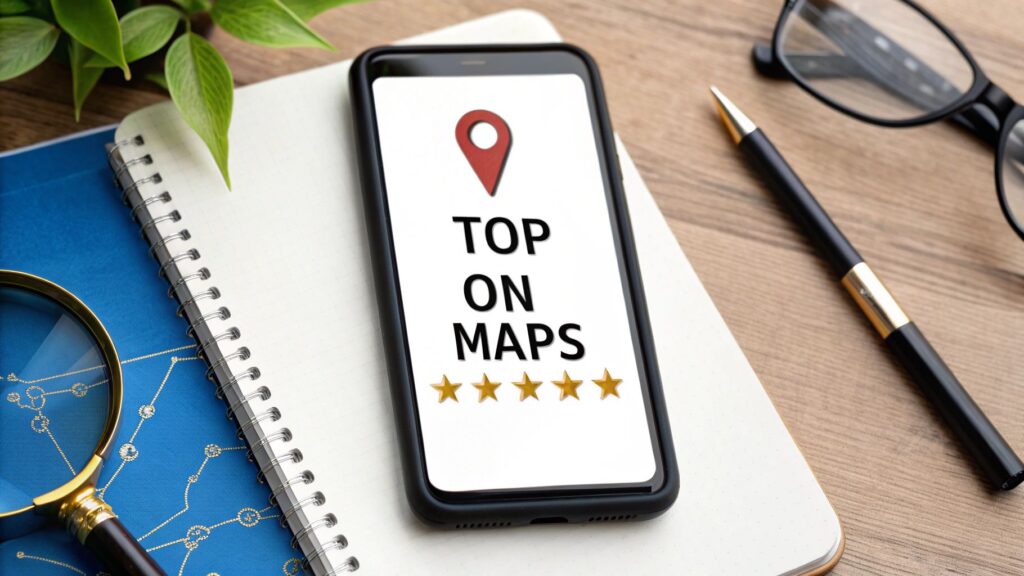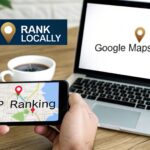If new patients can't find you on Google, your optometry practice is practically invisible. Optometry SEO is the process of fine-tuning your website so you show up first when someone searches for an "eye doctor near me."
Think of it as moving your practice from a quiet side street to the busiest intersection in town—but online. It’s how you get a consistent flow of new patient calls, straight from a Google search.
In Short: A solid optometry SEO strategy puts your practice right in front of local patients actively searching for eye care, building trust and driving appointments.
Why is SEO important for optometrists?
Word-of-mouth is great, but today the path to your exam chair almost always starts with a search bar. This is where optometry SEO becomes your most powerful tool for practice growth.
Your potential patients are searching for things like "dry eye treatment in [Your City]" or "pediatric eye exams near me." SEO makes sure your practice is the answer they find.
The Modern Patient Journey
The Yellow Pages are a relic. Today’s patients are savvy researchers. They look for signs of a trustworthy practice—like great reviews and a helpful website—before they even think about calling.
A smart SEO strategy puts you in their path at every step:
- Awareness: They find your practice through a simple Google search.
- Consideration: They read your blog post on "5 Signs You Need New Glasses" and see your expertise.
- Decision: They see your great ratings on Google Maps, click to your site, and book an exam.
This process funnels directly into more phone calls and booked appointments.
Standing Out in a Competitive Market
The online space for eye care is crowded. You're competing with other local optometrists and big retail chains. SEO is the great equalizer. It lets an independent practice like yours focus on what the giants can't: your local community.
When you invest in optometry SEO, you're building a lasting asset. Unlike an ad that disappears when you stop paying, a well-ranked page can bring you qualified patients for years. Learning the practical steps to implement search engine optimization is a game-changer.
The stats prove it. An incredible 70,000 health-related questions are asked on Google every minute. And searches for healthcare services "near me" have doubled since 2015. With an average close rate of 15% for organic search leads in healthcare, every 100 visitors from Google could mean 15 new patients.
The Core Pillars of Optometry SEO
Here’s a quick breakdown of what your practice needs to master.
| SEO Pillar | What It Means for Your Practice | Real-World Example |
|---|---|---|
| Local SEO | Dominating search results in your service area, especially the Google Map Pack. | A patient searches "optometrist in Springfield" and your practice appears in the top 3 map listings. |
| On-Page SEO | Optimizing the content on your website pages to tell Google what you offer and where. | Creating a dedicated service page for "Myopia Control" that uses the term in headings and text. |
| Content Creation | Writing helpful blog posts and FAQs that answer your patients' common questions. | Publishing an article titled, "What to Expect at Your Child's First Eye Exam." |
| Link Building | Earning "votes of confidence" from other reputable local websites through links back to your site. | Sponsoring a local sports team and getting a link from their website back to yours. |
Mastering these pillars makes it easier for local patients to find, trust, and choose your practice.
Winning Local SEO in Your Town
For most optometrists, winning at SEO means owning the search results in your own backyard. Local SEO is about showing up when a potential patient searches for an "eye doctor near me."
That journey, from search to booking, happens fast.

This simple flow—Search, Find, Book—shows how critical it is for your practice to appear in local map results when a patient needs you.
Your Most Powerful Local SEO Asset
Your Google Business Profile (GBP) is the most important tool in your local SEO arsenal. It's the info box in Google Maps and search results showing your clinic's name, hours, photos, and reviews.
Optimizing it is an ongoing task.
- Pick the Right Categories: Your main category should be "Optometrist." Add secondary ones like "Contact Lens Supplier" or "Sunglasses Store" if they fit.
- Fill Out Every Single Field: Add your specific services, accessibility info, and payment options. A complete profile builds trust.
- Use High-Quality Photos: Upload clear, professional shots of your office, team, and equipment. This helps people feel comfortable with your practice.
Keep Your Information Consistent
If a patient finds different phone numbers for you on Google, Yelp, and your website, they might give up. Google craves consistency.
Your Name, Address, and Phone number (NAP) must be identical across the web, including:
- Your Google Business Profile
- Your website's header, footer, and contact page
- Directories like Yelp, Healthgrades, and Vitals
- All your social media profiles
Inconsistencies hurt your rankings. For a deeper dive, check out this guide on local maps SEO.
The Power of Patient Reviews
Reviews are the lifeblood of local SEO. A steady stream of recent, positive reviews tells Google that your practice is trusted and active. More than 75% of people use online reviews to vet healthcare providers.
Key Takeaway: You can't just hope for reviews—you have to actively ask for them. A simple follow-up email or text with a direct link to your GBP review page works wonders.
Also, respond to every single review, good or bad. A professional response shows you care about your patients' experience.
Designing a Website That Books Appointments
Your website is your digital front door. If it's slow, clunky, or hard to navigate, it sends people straight to your competitors.
A great website, however, guides visitors from their first click all the way to a booked appointment. Smart on-page optometry SEO is how you make this happen.

What should I put on my optometry website?
When someone lands on your site, they want answers fast. Make sure this information is front and center:
- Your Services: Have dedicated pages for core offerings like comprehensive eye exams, contact lens fittings, or dry eye therapy.
- About Your Practice: Share your story. Post friendly photos and bios of your doctors and staff.
- Contact Info: Your phone number, address, and hours should be impossible to miss. Put them in the header, footer, and on a dedicated contact page with a map.
- "Book Now" Buttons: Place clear, bold calls-to-action (CTAs) on every page. Make scheduling an appointment easy.
How do I make my website SEO-friendly for eye doctors?
Making a site "SEO-friendly" is about clarity. Your job is to make it obvious to Google that you are the most relevant result for a searcher.
You do this with smart keyword placement. Think like a patient. What would they type into Google?
- A page titled "Services" is vague. "Comprehensive Eye Exams in [Your City]" is specific.
- "About Us" is okay, but "Meet Your Local [Your City] Optometrist" is better.
Weave these service- and location-based keywords into your page titles, headings, and text naturally.
The Bottom Line: A well-structured website uses descriptive titles and headings that tell both Google and your future patients exactly what they'll find on each page.
How can I improve my optometry website?
Keywords get people to your site, but user experience keeps them there. A poor user experience will cause visitors to leave, and Google notices that.
The biggest factor is mobile-friendliness. Most local searches happen on a smartphone. If your website is a pinch-and-zoom nightmare, you are turning away patients.
Your site also needs to be fast. A page that takes more than three seconds to load will send visitors bouncing back to search results. For a good example of a mobile-first design, look at a high-quality mobile landing page example.
Here's a quick checklist to improve user experience:
- Test on Mobile: Use Google's free Mobile-Friendly Test.
- Check Your Speed: Use a tool like PageSpeed Insights to see what's slowing you down.
- Simplify Your Menu: Keep navigation clean and simple.
- Use High-Contrast Text: Make your text easy to read, especially for older patients.
Creating Content That Connects with Patients
Great content builds trust and shows off your expertise long before a patient visits your clinic. It’s the engine behind your optometry SEO efforts, turning your website from a brochure into a helpful resource.
When you answer the questions your potential patients are Googling, you become the go-to authority for eye care in your town.

What content should an optometrist create?
Your best content ideas are the questions you hear every day in the exam room. Every "why does my eye…" is a great blog post topic.
Focus on two types of content:
- Service Pages: These are your core money pages. Create a detailed page for each key service like "Dry Eye Treatment" or "Pediatric Eye Exams." Explain the condition, the process, and why your practice is the best choice.
- Blog Posts: This is where you answer questions and build trust. You can help people who aren't ready to book an appointment yet but are researching their eye health.
How do you write a good blog for an optometrist?
Write like a helpful expert, not a stuffy textbook. Keep your tone friendly and easy to follow. Your goal is to educate and reassure, not overwhelm with medical jargon.
The best topics solve a real problem for your community.
Here are a few blog post ideas that perform well:
- "Managing Your Child's Screen Time to Protect Their Vision"
- "5 Signs It’s Time for a New Glasses Prescription"
- "What to Expect During Your First Glaucoma Screening"
- "Are Daily Disposable Contacts Worth It for Allergy Sufferers?"
Pro Tip: Keep a running list of questions you get from patients. This list is a goldmine of proven content topics.
What is an example of good content?
Good content is specific, actionable, and patient-first. Instead of a generic article about "eye health," create a detailed FAQ page about a specific condition like macular degeneration.
Think like a patient who was just diagnosed. What are their questions?
- What is Macular Degeneration? Explain it in simple terms.
- What are the early symptoms? Give them a clear, bulleted list.
- How is it treated? Outline the options you provide.
- Can lifestyle changes help? Offer practical advice on diet and supplements.
This type of focused content answers a searcher's needs and positions your practice as a caring, knowledgeable provider.
Building Authority Through Local Partnerships
When it comes to optometry SEO, getting links from other credible websites (called backlinks) is like getting a referral from a trusted colleague. Google sees these links as powerful votes of confidence.
This is about building real-world relationships that naturally turn into powerful online signals.
How do I get local backlinks for my optometry practice?
Getting high-quality local links starts with looking at your role in the community. Your existing connections are the best source for valuable backlinks.
Here are a few strategies that work:
- Team Up with Other Health Providers: Offer to write a guest post for a local pediatrician or family doctor's blog. They get helpful content, and you get a relevant link back to your site.
- Sponsor a Local Event: Supporting a community 5K, a little league team, or a charity is a great way to build goodwill. They will often link to your practice on their sponsors page.
- Join Local Business Groups: Get active in your local Chamber of Commerce. These groups usually have an online member directory with a link to your website.
The best link-building strategies for an optometrist are rooted in genuine community involvement.
Identifying Your Best Partnership Opportunities
A link from another business your patients already trust carries a lot of weight.
Start by brainstorming a list of potential partners in your area:
- Local schools and universities
- Senior living communities
- Corporate wellness programs
- Local news outlets or community bloggers
Reach out with a specific idea that benefits both of you. Offer to host a "Healthy Vision" workshop or provide a vision screening day. These activities often lead to a feature on their website, complete with a backlink. This outreach is a key part of any smart doctor marketing plan.
Why Local Partnerships Matter More Than Ever
Building these local connections does more than earn backlinks; it cements your status as a trusted community healthcare provider. The vision care industry is growing, and the global optometry equipment market is projected to hit USD 5.8 billion by 2028.
This growth underscores how critical strong online visibility is. By building real authority in your local community, you're positioning your practice to capture a larger share of this market. You can learn more about these optometry marketing trends and insights on cardinaldigitalmarketing.com.
Commonly Asked Questions About Optometry SEO
Diving into optometry SEO can bring up a few questions. Let's tackle some of the most common ones we hear from optometrists.
How long does it take for SEO to work for an optometrist?
Patience is key. You can often see some movement in the first 2-3 months, especially from local SEO tweaks like optimizing your Google Business Profile.
But for more competitive keywords, you’re playing a longer game. It usually takes 6 to 12 months of consistent effort to see a significant, steady flow of organic traffic and new patient calls.
The Bottom Line: SEO is a marathon, not a sprint. The work you do today builds on itself over time. Consistency is everything.
Can I do SEO myself for my optometry practice?
Yes, you can! Handling the fundamentals yourself is a great way to start.
If you go the DIY route, focus on these for the biggest impact:
- Master your Google Business Profile: Fill it out completely and add fresh photos and posts often.
- Make reviews a habit: Create a simple process for asking happy patients for a review, and respond to every one.
- Write helpful blog posts: Start by answering the top 5-10 questions you hear from patients every week.
That said, if you're in a competitive city or want faster growth, partnering with an agency that understands healthcare marketing can give you a major advantage.
What is the difference between SEO and local SEO?
Think of it like this: SEO is the big umbrella, and local SEO is a specialized practice under it.
- General SEO aims to rank a website for broad topics to a national or global audience. For example, a big health website might try to rank for "what is glaucoma?"
- Local SEO focuses on ranking your practice for searches made by people in your specific service area. The goal is to appear for searches like "glaucoma specialist in Boston."
For an optometry practice, local SEO is your top priority. It's what drives patients to your physical location.
At Clicks Geek, we specialize in helping local service businesses—including optometrists—build a dominant online presence that drives real, measurable growth. If you’re ready to turn your website into your most effective patient magnet, check out our SEO and digital marketing solutions.
Is Your Business Ranking in Google Maps?
Turn Google Maps into a Lead Engine w/ Clicks Geek’s AI-powered local SEO. 3,000+ clients served. Our proprietary, fully done-for-you Maps SEO system handles everything—keyword targeting, local optimization, content, reviews, and ranking strategy—automatically.






